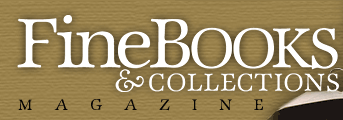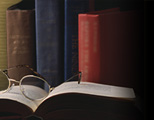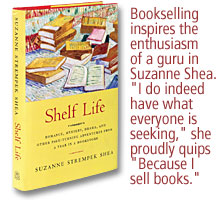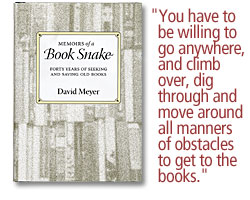| |
 |
 |
 |
Shelf Life
By Suzanne Strempek Shea
Boston: Beacon Press, 2004
223 pages. $20.00
ISBN 0807072583
Books about books is a misnomer of a genre name.
If these titles were strictly about books, and nothing else, they
would be title catalogs threaded with wisps of narratives: “And
then I bought this. And then I sold that.” Such flat enumerations
would numb the soul of the most passionate bibliophile. The best
books about books are about books and people, specifically, about
the sellers, collectors, enthusiasts, and oddballs, including the
authors themselves. The people must be as interesting as the books.
Shelf Life is primarily about people, emphasizing the relationships
that a bookstore can foster among employees and customers, and even
bridging the canyon between sellers and buyers.
Shea is a writer whose previous book, Songs
from a Lead-Lined Room, described her diagnosis and treatment for
breast cancer. Following her recuperation, she took a job at Edwards
Bookstore in Springfield, Massachusetts, at the request
of friend and storeowner, Janet Edwards. Much to her surprise, the
author became an employee of a retail bookstore, stocking shelves,
filling back-orders, and arranging window displays. She captures
the mundane mechanics of selling new books, including the drudgery,
the frustrations, and the job’s greatest satisfactions—answering
questions and helping customers.
Edwards’s customers provide the book’s most humorous
and illuminating stories. A woman who needs a magazine article
calls the store and asks, “I don’t suppose you
could… cut out the article I want and mail it to me?”
A traveling businessman wants “something I’ll just read
and forget.” Shea considers creating a window display—Books
That Won’t Make You Think—but discreetly shelves the
notion. There are schoolchildren whose excitement about books is
not dampened by required reading lists and customers who would sooner
skip their morning cup of coffee than their regular shop visits.
An older gentleman, awkward and unsure, wants to know how to talk
with women or, more specifically, how to rekindle a romance
with one particular woman. “I’ve found the right one,”
he says. “I just don’t want to make a mistake.”
Any bookseller or librarian will recognize these characters.
These professions are kindred specialties. Both field questions
and decipher the wants of their patrons, finding the right book
for the right person on the right occasion. They wield empathy and
patience to understand what their customers need, especially when
their customers aren’t aware themselves what exactly they
want. It inspires the enthusiasm of a guru in Shea. “I
do indeed have what everyone is seeking,” she proudly quips.
“Because I sell books.”
Janet Edwards has run the store for nearly thirty years, and
her presence in the community is at once rock solid and catalytic.
“The customers call the store Janet’s because Janet
is the heart, the soul, the furnace from which emanates the warmth,
smarts, unflagging energy and goodwill that, despite the rather
hidden location, a ping-ponging economy, and big-box competition,
keeps the place alive.” Her coworkers (all of whom are women)
have a tight-knit symbiosis with the store. It’s not simply
a job for them, but a second family, providing close company, emotional
support, and potluck dinners. Janet correctly claims, “This
is a family business. We only hire family.”
Shea finds herself in the curious position of being an author
in a store selling authors’ wares, straddling several links
in the publishing food chain. She surreptitiously uses her position
arranging the store’s displays to promote her own titles at
the expense of big-name authors like John Grisham, who needs no
help moving volumes. When she recommends one of her books to a potential
buyer with a modest “I’ve heard it’s quite good,”
the woman responds, “Doesn't look it.”
There is another fascinating character at the center of
Shelf Life—the bookstore itself, a destination drawing people
of different backgrounds together to learn, exchange information,
and interact with each other. It’s a case study of the
bookstore in the ecology of a community. The story of Edwards Books
encompasses the story of Springfield, an industrial city in western
Massachusetts trying to revitalize itself after industry has abandoned
it. Stores like Edwards’s are institutions that form the DNA
of a good community, and like the strands of life, they are entwined
in its survival.
There are thousands of retail bookstores in the United States,
yet comparatively few are so special that they create a sense of
ownership in the community. Shea links the demise of
so many independents to the enormous inventories and influential
buying power of chain stores. “All the more reason,”
she suggests, “for traditional stores to stress ‘Let
me find that for you.’” Small, personal courtesies pay
off when customers tell her, “I could have gotten this online
for thirty percent off…but I wanted to do business here.”
That single statement may point to the major problem confronting
many independent bookstores today—and to a possible solution.
Shelf Life is a personal missive from the frontline of
the independent bookstore struggle. Shea warmly observes this world
and captures her colleagues’ and her own enthusiasm, but doesn’t
romanticize it. Bookselling, for all the magic bibliophiles find
in it, is also mundane, and Shea’s readers might see how difficult
and tiresome running a bookstore can be. Seasons and years pass,
children grow up and leave town, catastrophe strikes, wars come,
old friends pass on—but as of this review, Shea still works
at Edwards Books.
By David Meyer
Glenwood, Ill.: Waltham Street Press, 2001
152 pages. $23.00
ISBN: 0916638545
The malapropism “book snake” is applied
to David Meyer by an acquaintance reaching for the word “bookworm.”
“Snake” suggests a creature that navigates hazardous
terrain and tight corners in a single-minded pursuit of its prey.
“You have to be willing to go anywhere, and climb over, dig
through, and move around all manners of obstacles to get to the
books,” Meyer writes.
As a boy, he accompanied his father on weekly visits to
Chicago bookstores in the 1950s. The chapter, “The Bookmen
of My Youth,” remembers them, especially Bill Newman’s
Gallery Bookstore and the antiquarian department on the third floor
of Marshall Field, “when it was still the great department
store it had been for nearly a hundred years.” Meyer also
relates the fascinating story of Reinhold Pabel, a German soldier
interred stateside during the Second World War. Pabel escaped from
his prison camp, married, and opened the Chicago Book Mart before
he was caught by the FBI in 1953. He recounted his story in the
1955 book, Enemies Are Human. “If you bought ten dollars’
worth of books from Pabel,” Meyer remembers, “he offered
you a free copy.”
The book’s strongest chapter is a profile of Margaret
Donovan DuPriest. Meyer started his career as a “sometime
bookseller” at Maggie’s Old Book Shop in South Miami.
She’s truly a character: “As I dusted the books…I
read titles and checked contents with an idea toward purchasing
books for myself. Maggie frowned on this habit… She did not
consider me a customer, and it was the customers, not the help,
whom she was saving her books for. She may have also not liked the
idea of paying me, only to have the money handed back to her.”
On a whim, she later moved the store north to Greenwich Village
and rechristened it the DuPriest Book Shop, and then relocated it
a year later to Columbia, South Carolina, where she was disappointed
by a literary life less lively than that of New York. Maggie
would be a first-rate protagonist in her own story.
Meyer’s biography is filled with a similar wanderlust.
After college and military service in Vietnam, he traveled the country,
hunting for treasures in bookshops and uncommon places. Along the
way, he encounters remarkable titles, authors, and friends,
whom he often associates with a particular discovery.
Memoirs of a Book Snake almost falls
into the “And then I bought this” class of books about
books. Meyer likes to relate his great finds, bargains he later
resold for substantial sums, but the real highlights are the fascinating
people he meets. Meyer tells a good story and evocatively describes
several book people who should be remembered by collectors. The
chapters are brief, and so is the book itself, a small five-by-seven
inch volume. Unlike many self-published volumes, this is a little
book worth scouting.
Pasco Gasbarro |
|
|


